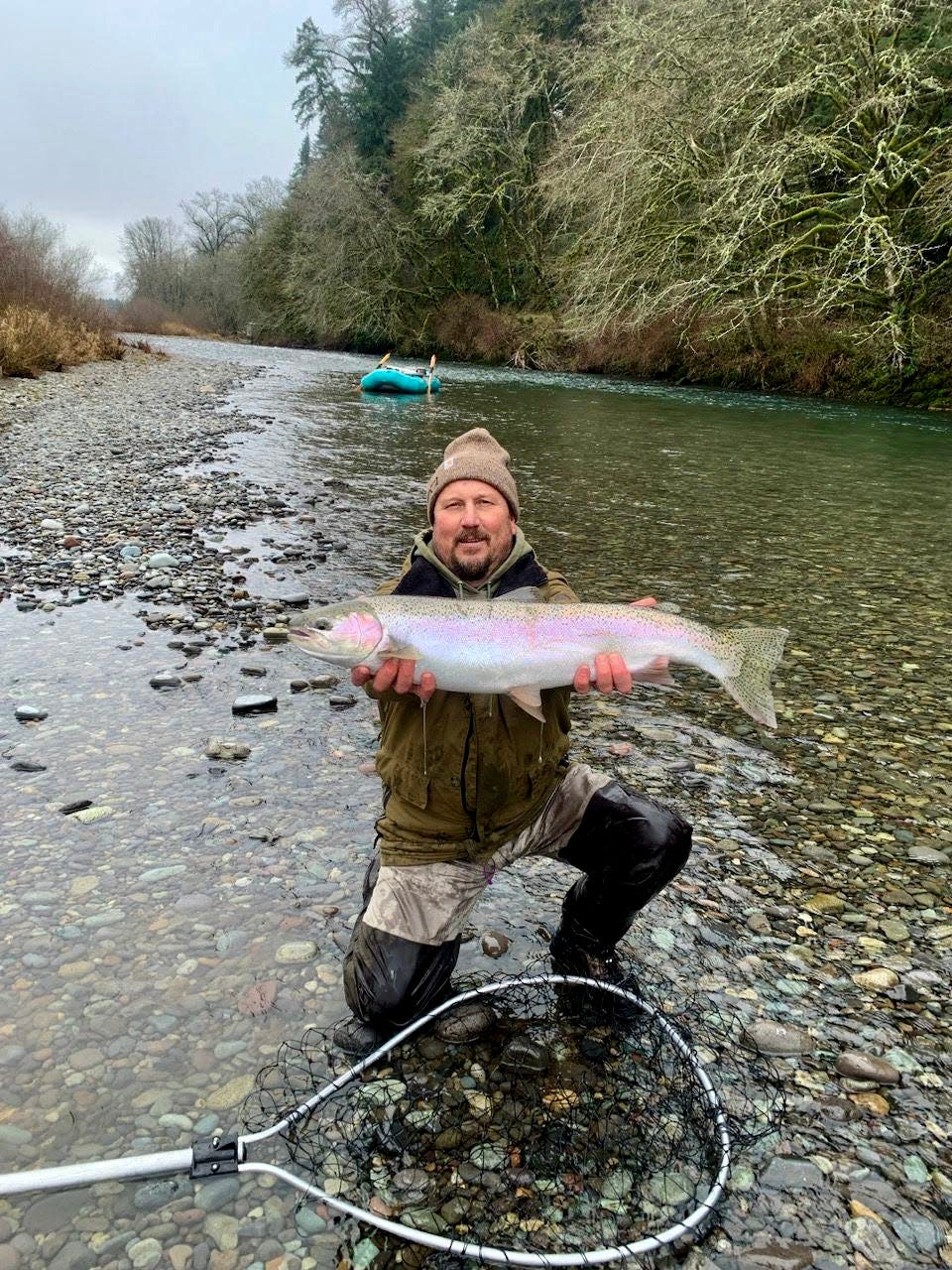Once in 'extinction vortex,' Willamette winter steelhead post best returns since 2004
The number of winter steelhead returning to the Upper Willamette Basin reached its highest level in two decades this season, providing hope that the ocean-going trout can rebound after a near population collapse in 2017.
So far, 7,630 winter steelhead have migrated upstream of Willamette Falls, the most since 2004, according to data from the Oregon Department of Fish and Wildlife. Another thousand or more are possible this season.
Chrome-colored and powerful, wild winter steelhead numbers crashed to just 822 fish in 2017, entering what biologists called the “extinction vortex" — meaning they could have been gone for good. Their numbers have stabilized since, but returns have averaged just 3,100 per year compared to more than 20,000 in the 1970s and 80s.
Steelhead migrate to the ocean and return to major tributaries such as the Santiam, Molalla and Yamhill. They've been listed as “threatened” under the federal Endangered Species Act since 1999.
“It is good to see such a strong Willamette winter steelhead run after the recent poor run years,” ODFW Mid-Willamette district fish biologist Elise Kelley said.
Uptick allows some anglers catch-and-release
This season's increase allowed anglers the rare chance to catch-and-release the large, athletic fish. A number of anglers caught winter steelhead on the North Santiam River, took a picture and released them — a practice that is allowed under ODFW regulations using artificial flies and lures.
Brothers Tony and Mike Frolov caught and released winter steelhead multiple times this season, including a trip where they hooked nine and landed four.
“We’ve been fishing winter steelhead on the Santiam for 20 or 25 years, and this was by far the best the fishing has been,” Mike Frolov said. Wild winter steelhead are larger and more powerful than hatchery-raised summer steelhead that anglers can catch and keep in the Santiam.
Frolov estimated the fish he caught at 12.5 to 13 pounds. The summer steelhead are often 5-7 pounds, or less.

“When you look at the numbers and how they’ve declined, you just want to take advantage of these opportunities because in 20 years, we might not be able to,” Mike Frolov said. “It’s a great bounce back year, but it does feel temporary. Hopefully I am wrong about that.”
Anglers can harvest hatchery summer steelhead from the North Santiam and other Willamette Basin rivers. Hatchery summer steelhead have their adipose fin removed while wild steelhead have theirs intact.
Reason for the uptick in winter steelhead?
Fish biologists say the biggest reason for the increase is improved ocean conditions — the amount of food available to anadromous fish. Coho salmon numbers also broke records this past year in the Upper Willamette Basin. And in general, other ocean-going Oregon fish have seen numerical improvements in recent years.
“If you had to pick the one biggest thing to explain it, it would be the ocean,” said Greg Taylor, a fish biologist for the U.S. Army Corps of Engineers. “But there is a lot going on. Winter steelhead spend two years in freshwater and two years in the ocean, which means these runs are impacted by a million different factors and variables.”
In the last two years, Oregon also has had less drought and generally better conditions in rivers for fish.
Another big variable is sea lions. In the mid to late 2010s, state biologists said California sea lions were eating 25% of the run from below Willamette Falls and at its fish ladder. With already low numbers, the sea lions pushed the winter steelhead toward the possibility of going extinct.
Since officials were given the power to kill sea lions at the site starting in 2019 — those that became habituated to eating the fish — the number of fish eaten has gone way down.
“We’re excited to see some of the best winter steelhead returns in recent years,” Dr. Shaun Clements, ODFW senior policy analyst, said after the sea lion removal program started in 2019. “We’re encouraged by the fish numbers and by the success in implementing the sea lion removal program. We’ve definitely been able to provide some relief to the fish.”
Wild steelhead face a gauntlet of challenges
Even with less sea lions to navigate and better ocean conditions, the wild fish still faced a gauntlet of challenges from dams to drought, said Mark Sherwood, executive director of the Native Fish Society.
His group has advocated for dam policies to improve conditions for wild steelhead, such as additional water releases and fish passage.
“This incredible class of fish had to live through two years of drought (2021 and 2022) and the 2020 wildfires — they certainly didn’t have a cake walk,” Sherwood said. “I think what it shows is that given half a chance, these wild fish can thrive.”
He said one-third of the winter steelhead run travels into the Molalla River, which is un-dammed and has been “managed to support wild fish since the 2000s.”
“Wild fish will capitalize on any good conditions they get, which is why we have to keep working to improve habitat and conditions for them on rivers throughout the Willamette Basin. That’s how we keep this going.”
Correction: A previous version of this story said winter steelhead migrate up the McKenzie River. However, native wild winter steelhead never made it that far in the Upper Willamette system.
Zach Urness has been an outdoors reporter in Oregon for 15 years and is host of the Explore Oregon Podcast. To support his work, subscribe to the Statesman Journal. He can be reached at zurness@StatesmanJournal.com or (503) 399-6801. Find him on Twitter at @ZachsORoutdoors.
This article originally appeared on Salem Statesman Journal: Willamette winter steelhead post best returns since 2004
